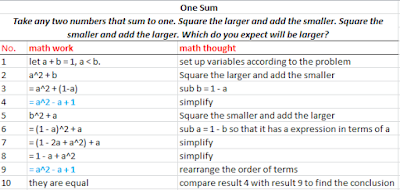Monday, November 23, 2015
2-column solution problem_one sum
Here is the solution I constructed for the two-column solution problem.
The question is called One Sum, from John Mason's Thinking Mathematically on page 208.
Dave Hewitt: Arbitrary and Necessary
2) How might this idea influence how you plan your lessons, and particularly, how you decide "Who does the math" in your math class?
Reflection on Dave Hewitt's teaching video
The counting numbers strategy is wonderful! Dave first knocked the blackboard to make noise to attract students' attention. He then start to count "1" with a knock, "2" with a knock right to the previous knock, and so on. After counting "7", he started to knock the next one without counting the number. The next moment was amazing: students started to count "8" with him. He then knocked the next one and students responsed by "9". After several knocks and responses, he orally called "dot, dot, dot" and knocked the wall with calling "20". Students responsed the next knock with "21". Dave repeated the game until he moved to the back of the classroom and said "1,000,000". He started to knock backward and students quickly figured out the trick. When he knocked a place left to the zero, students started to called "-1". Then Dave started to knock multiple places and waited for response. Students were able to response correctly as well. Then this is the moment he started to introduce plus and minus integers.
Dave provided students long pauses after questioning, and actively performed to engage students. Even if some students had their hands raised, Dave still waited a few more seconds for the whole class to digest the information and make sure everyone has been on the right track. This is a strategy I need to use in my class.Wednesday, November 18, 2015
SNAP fair?
MOA Math Fair
Several interesting things I like to mention about the math fair in MOA.
First, students were enthusiastic. Sissi and I tried all the problems with students' invitations.
Second, problems were well-stated and mathematically enlightful, although some problems were mathematically identical under different scenarios.
(a) One interesting problem was to find a "winning strategy" of a game:
Two players in turn take one or two ships away from the ocean. There are 6 ships in the ocean. Whoever takes the last ship away wins the game.
Another similar game was to remove trees from land.
All the two games shared the same mathematical concepts. It required students to think backward and understand some number theory. The senarios were interesting as well: the ocean one can be considered as an "environmental" topic, while the second one reflected the terrible result of over-lumbering.
(b) Another interesting problem is a changing-position senario. There are seven places placing along a line (consider it is a number axis from -3 to 3, namely, -3, -2, -1, 0, 1, 2, 3). Three birds occupy -3, -2, -1, while three ducks take places of 1, 2, 3. Birds and ducks want to switch positions, but a bird can only move to a larger number, while a duck can only move to a smaller number. A place cannot be occupied by a bird and a duck at the same time. All the animals can move to an empty adjacent place, or jump above another animal to the next empty place.
Studetns mentioned that this problem had taken them three days to be solved. And there was another similar problem but different animals.
(c) There are 9 objects with identical shape. One of them is over weight. Here is a scale that one can measure if the weights on both sides are equal or not, but it cannot measure the exact value of weight. How many times can you find the over-weight object?
The smallest number of trials should be 2, but the student serving this problem believed it to be 3. The good thing is that I only did similar problems on book and in mind, but I have never tried it with my hands! Wonderful!
All in all, students were all engaged and the math fair was fun! Enjoy the happiness of using/learning mathematics. This is the main goal.
